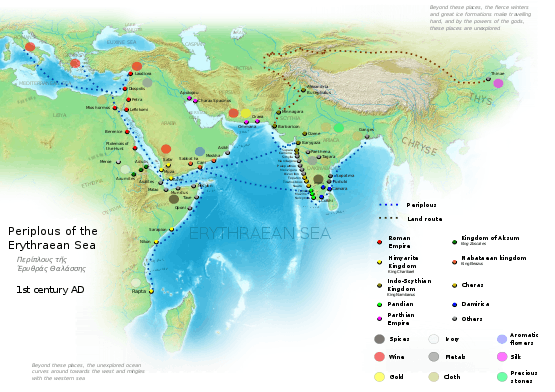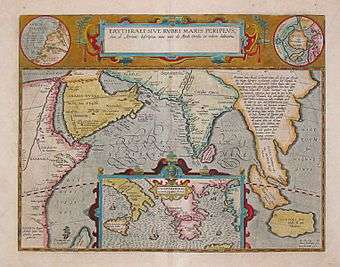Erythraean Sea
The Erythraean Sea (Greek: Ἐρυθρὰ Θάλασσα, Erythrà Thálassa, lit. "Red Sea") was a former maritime designation that always included the Gulf of Aden and at times other seas between Arabia Felix and the Horn of Africa. Originally an ancient Greek geography, it was used throughout Europe until the 18-19th century. At times the name frequently extended beyond the Gulf of Aden—as in the famous 1st-century Periplus of the Erythraean Sea—to include the present-day Red Sea, Persian Gulf, and Indian Ocean as a single maritime area.[1]
| Erythraean Sea Ἐρυθρὰ Θάλασσα | |
|---|---|
 An eighteenth century map showing the Erythraean Sea off the Horn of Africa. Drawn by James Rennell (1799) | |
| Location | Northwestern Indian Ocean |
| Coordinates | 12°0′N 55°0′E |
| Type | Sea |
| Basin countries | Yemen, Somalia |
Name
The Greeks themselves derived the name from an eponymous King Erythras, knowing that the waters so described were deep blue.[2][3][4] Modern scholars sometimes attribute the name to seasonal blooms of the red-hued Trichodesmium erythraeum in the Red Sea.[5]
According to Agatharchides, a Persian man lived near the sea and islands in the time of the Medes under the name of Erostras and became popular and became widely known for calling the sea his name. Strabo considers his tomb on the island of Oguris. Researchers call the island one of the islands of Qeshm or Hormuz.[6][7][8]
Erythraean Sea was the term applied by Greek and Roman geographers to the entire Indian Ocean, including its adjuncts, the Red Sea and the Persian Gulf. Erythra means Red, so that the modern name perpetuates the ancient; but we are assured by Agatharchides that it means, not Red Sea, but Sea of King Erythras, following a Persian legend. The following is the account given by Agatharchides of the origin of the name: (De Mari Erythraeo, § 5.)
Here is manifestly a kernel of truth, referring, however, to a much earlier time than the Empire of the Medes and their capital Pasargadae. It suggest the theory of a Cushite-Elamite migration around Arabia, as set forth by Glaser and Hommel: the story of a people from Elam, who settled in the Bahrein Islands and then spread along South Arabia, leaving their epithet of "Red" or "ruddy" in many places, including the sea that washed their vessels: "Sea of the Red People," or, according to Agatharchides, "of the Red King." See under §§ 4, 23, and 27.
Opone is the remarkable headland now known as Ras Hafun, 10° 25′ N., 51° 25′ E., about 90 miles below Cape Guardafui.
Glaser finds a connection between these names, Pano and Opone, the Egyptian "Land of Punt" or Poen-at, the island Pa-anch of the Egyptians (Socotra), the incense-land Panchaia of Virgil (Georgics, II, 139; "Totaque turiferis Panchaia pinguis arenis,") and the Puni or Phoenicians; who, he thinks, divided as they left their home in the Persian Gulf (the islands of King Erythras in the story quoted by Agatharchides); one branch going to the coasts of Syria, the other to those of South Arabia and East Africa. [9] [10] [11]
Use
The name "Erythraean Sea" has been or is still used for the following places:
- In the opening sentences of Herodotus's history, written in the 5th century BC, he refers to the Phoenicians having come originally from the Erythraean Sea.
- In the Periplus of the Erythraean Sea, written in the 1st century AD, as well as in some ancient maps, the name of the sea refers to the whole area of the northwestern Indian Ocean, including the Arabian Sea.[12]
- In centuries past, the name "Erythraean Sea" was applied by cartographers to the NW part of the Indian Ocean, mainly the area around Socotra, between Cape Guardafui and the coast of Hadhramaut. This appellation has now become obsolete and the name Gulf of Aden is used, although for a smaller area. In maps where the NW Indian Ocean is named thus, the Red Sea appears as "Arabian Gulf".
- The name "Erythraean Sea" was used as well to refer to some gulfs attached to the Indian Ocean, specifically, the Persian Gulf.[13]
- As a name for the Red Sea, especially after the 19th century. The modern country of Eritrea was named after this ancient Greek name.
- Since 1895, the name has also been applied to a large dusky region on the surface of planet Mars, known as Mare Erythraeum.
 Names, routes and locations of the Periplus of the Erythraean Sea. |
 17th-century map depicting the locations of the Periplus of the Erythraean Sea. |
See also
References
- "Somalia - Gulf of Aden | Africa | Peace Operations Update | Publications | ZIF - Center for International Peace Operations".
- Agatharchides.
- Wilfred H. Schoff, Periplus of the Erythraean Sea, notes on §1.
- Flavius Philostratus, Life of Apollonius of Tyana, Book III, chapter 50.
- "Red Sea". Encyclopædia Britannica Online Library Edition. Encyclopædia Britannica. Retrieved 2008-01-14.
- https://www.amazon.com/Persian-Gulf-1928-Hardcover/dp/9333394958 The Persian Gulf 1928 (Page44) Arnold T Wilson
- https://www.loebclassics.com/view/LCL182/1924/volume.xml Strabo 1966 LOEB CLASSICAL LIBRARY Vol 5&7 (Page 3&4) Geographica
- Strabo (July 1989). Geography, Volume VII: Books 15-16. ISBN 0674992660.
- "Periplus of the Erythraean Sea".
- "The Voyage around the Erythraean Sea".
- "The Periplus of the Erythraean Sea and the Persian Gulf | SILK ROADS".
- 1794, Orbis Veteribus Notus by Jean Baptiste Bourguignon d'Anville
- Schoff, Wilfred H. (Wilfred Harvey) (1912-01-01). The Periplus of the Erythræan sea; travel and trade in the Indian Ocean. New York : Longmans, Green, and Co. pp. 50 – via Internet Archive.
External links
- The Periplus of the Erythrean sea, containing an account of the navigation of the ancients, from the sea of Suez to the coast of Zanguebar, William Vincent (ed.), 2 voll., London, 1800, vol. 1, vol. 2.
- William H. Schoff, The Periplus of the Erythraean Sea: Travel and Trade in the Indian Ocean by a Merchant of the First Century (New York: Longmans, Green, and Co., 1912), with additional commentary including alternate spellings or translations from Lionel Casson's more recent edition.